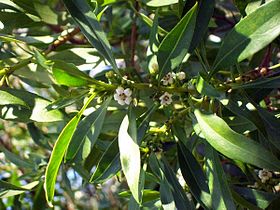- Myoporum acuminatum
-
Pointed Boobialla 
Scientific classification Kingdom: Plantae (unranked): Angiosperms (unranked): Eudicots (unranked): Asterids Order: Lamiales Family: Scrophulariaceae Genus: Myoporum Species: M. acuminatum Binomial name Myoporum acuminatum
R.Br.Myoporum acuminatum, commonly known as Waterbush, Pointed Boobialla or Mangrove Boobialla, is a plant found in eastern Australia. It grows in rainforest or wet eucalyptus forest near the coast, and is often associated with mangroves. Occasionally it is found in the drier rainforests. It grows naturally as far south as Mimosa Rocks National Park in far south eastern New South Wales, and north to Queensland, the islands of the Torres Strait and New Caledonia.
Contents
Taxonomy
The plant first appeared in scientific literature in Prodromus Florae Novae Hollandiae in 1810, authored by Robert Brown.[1] The genus name Myoporum refers to the Ancient Greek roots myein ("to shut close") and πόρος ("passage", the same root that gave "pore"), referring to these plants' ability to close the stomata and persist in drier areas. The specific epithet acuminatum refers to the pointed leaves. Common names include Boobialla, Pointed Boobialla, Waterbush and Mangrove Boobialla.[2]
Description
Myoporum acuminatum grows as a hairless shrub or small tree, up to 13 metres (40 ft) tall and a trunk diameter of 50 cm (20 in). In larger plants the trunk may be irregular in shape with flanges. Bark is greyish brown and somewhat wrinkled in larger trees. Small branches are green and fairly thick, though smooth.[2]
Leaves
Leaves are 5 to 14 cm long and 7 to 28 mm wide[3] with a fine point, though rarely seen with a rounded end. The base of the leaf becomes thin near the leaf stem, which measures 6 to 20 mm long. Leaf edges may be finely toothed, or smooth. Leaves lack stipules. Oil dots of varying sizes may be seen under a magnifying lens, of a distance apart of 3 to 5 diameters. Only the midrib is easily seen, other lateral or net veins are obscure.[2]
Flowers and fruit
Flowers appear from May to August, though later in the southern parts of its range. Flowers feature five white petals, with four rows of purple spots and a sweet scent. They grow in clusters from the leaf axils. [2]
The fruit is a roughened, wrinkled drupe. Globular in shape, 5 mm in diameter, blue or purple in colour. Remnants of the flower style point out of the fruit, 3 to 4 mm long and hooked. Inside are two to four seeds, maturing from October to February.[2]
Distribution and habitat
It grows in rainforest or wet eucalyptus forest of eastern Australia, from Queensland to the far south coast of New South Wales.[3]
References
- ^ "Myoporum acuminatum R.Br.". Australian Plant Name Index (APNI), IBIS database. Centre for Plant Biodiversity Research, Australian Government. http://www.anbg.gov.au/cgi-bin/apni?taxon_id=34041.
- ^ a b c d e Floyd, A.G., Rainforest Trees of Mainland South-eastern Australia, Inkata Press 2008, ISBN 9780958943673 page 412
- ^ a b "Myoporum acuminatum". PlantNET - NSW Flora Online. http://plantnet.rbgsyd.nsw.gov.au/cgi-bin/NSWfl.pl?page=nswfl&lvl=sp&name=Myoporum~acuminatum. Retrieved 2010-09-14.
Categories:- Myoporum
- Flora of New South Wales
- Flora of Queensland
- Flora of New Caledonia
- Lamiales of Australia
- Trees of Australia
- Plants described in 1810
Wikimedia Foundation. 2010.
